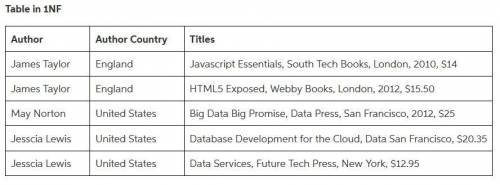
Computers and Technology, 07.04.2020 02:52, brutcherk
Charlie has a large book collection. He was keeping track of it in a spreadsheet, but it has grown big enough that he wants to convert it into a real database. Here is a sample from the spreadsheet: Author James Taylor Author Country England May Norton United States Titles JavaScript Essentials, South Tech Books, London, 2010, $14; HTML5 Exposed, Webby Books, London, 2012, $15.50 Big Data Big Promise, Data Press, San Francisco 2012, $25 Database Development for the Cloud, Data Press San Francisco, $20.35; Data Services, Future Tech Press, New York $12.95 Jessica Lewis United States Ques. 1. What are some of the potential problems with this layout if carried directly to the database? (Exam2.docx) Ques. 2. Create the Dependency Diagram and transform it into the highest normal form (Show various stages - INF, 2NF, 3NF). Be sure to show the primary keys, and various dependencies in each stage (Exam2.docx) Ques. 3. Create the final ER diagram that shows the database in the highest Normal Form. (Indicate PK, FK, data types). You can add additional attributes as needed. (Exam 2.docx) Ques. 4. Write a single script file (Label it as Exam2.sql) to create the tables and insert the sample data in Oracle. Confirm that the rows are created, and data is inserted. Use echo and spool to create an output file (Label it as Exam2_Output. txt)

Answers: 1
Other questions on the subject: Computers and Technology

Computers and Technology, 22.06.2019 19:30, 710jonathan
The following is an excerpt from a slide presentation. today we will inverse operations solving equations using inverse operations solving inequalities using inverse operations from which part of the presentation does the slide most likely come from? a. introduction b. outline c. body d. conclusion
Answers: 1


Computers and Technology, 23.06.2019 17:30, Annlee23
When making changes to optimize part of a processor, it is often the case that speeding up one type of instruction comes at the cost of slowing down something else. for example, if we put in a complicated fast floating-point unit, that takes space, and something might have to be moved farther away from the middle to accommodate it, adding an extra cycle in delay to reach that unit. the basic amdahl's law equation does not take into account this trade-off. a. if the new fast floating-point unit speeds up floating-point operations by, on average, 2ă—, and floating-point operations take 20% of the original program's execution time, what is the overall speedup (ignoring the penalty to any other instructions)? b. now assume that speeding up the floating-point unit slowed down data cache accesses, resulting in a 1.5ă— slowdown (or 2/3 speedup). data cache accesses consume 10% of the execution time. what is the overall speedup now? c. after implementing the new floating-point operations, what percentage of execution time is spent on floating-point operations? what percentage is spent on data cache accesses?
Answers: 2

Computers and Technology, 23.06.2019 18:00, joybeth9591
What can a word user do with the customize ribbon dialog box? check all that apply. minimize the ribbon add a new tab to the ribbon remove a group from a tab add a group to a tab choose which styles appear choose which fonts appear choose tools to appear in a group
Answers: 1
Do you know the correct answer?
Charlie has a large book collection. He was keeping track of it in a spreadsheet, but it has grown b...
Questions in other subjects:

Mathematics, 09.12.2020 19:50

English, 09.12.2020 19:50

History, 09.12.2020 19:50





Mathematics, 09.12.2020 19:50


Mathematics, 09.12.2020 19:50







